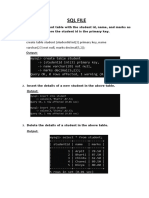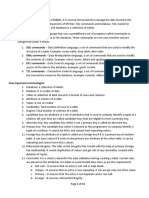0% found this document useful (0 votes)
39 views2 pagesSQL Practical Preparation Questions
The document contains a series of SQL practical preparation questions aimed at creating and manipulating a Student table. It includes tasks such as creating a table, inserting records, updating and deleting data, performing queries with conditions, aggregating data, and managing database constraints. The questions also cover advanced SQL concepts like joins, views, and indexing.
Uploaded by
abhisheksali18Copyright
© © All Rights Reserved
We take content rights seriously. If you suspect this is your content, claim it here.
Available Formats
Download as PDF, TXT or read online on Scribd
0% found this document useful (0 votes)
39 views2 pagesSQL Practical Preparation Questions
The document contains a series of SQL practical preparation questions aimed at creating and manipulating a Student table. It includes tasks such as creating a table, inserting records, updating and deleting data, performing queries with conditions, aggregating data, and managing database constraints. The questions also cover advanced SQL concepts like joins, views, and indexing.
Uploaded by
abhisheksali18Copyright
© © All Rights Reserved
We take content rights seriously. If you suspect this is your content, claim it here.
Available Formats
Download as PDF, TXT or read online on Scribd
/ 2

























































